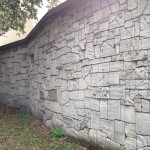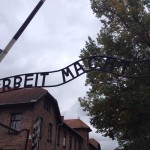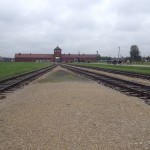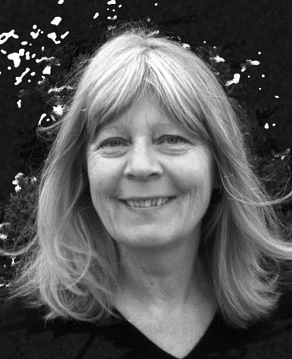Pick up at the hotel at 11am, return at 7pm. A tour to Auschwitz with about 20 people in our bus from six different countries. Throughout the 70 minute bus ride a DVD of the 1986 film THE LIBERATION OF AUSCHWITZ, by Irmgard von zur Mühlen, in Polish with English subtitles. I felt sick when we finally arrived, the film had done its job. We were assigned to the language we had requested. There were about 20 different ones offered every day and while the organizers ran around calling and waving signs and putting stickers on our jacket not to get lost in the turmoil of visitors pouring out of huge tour busses, the film I had just seen, faded away and last year’s visit to King Ludwig’s castles in Bavaria came to my mind. Was I visiting a Polish Museum with a permanent blockbuster exhibition? “The tour starts in 5 minutes, ” announced a young woman. “It will last about 90 minutes. Bathrooms are downstairs, drinks and small snacks can be purchased and must be consumed before the tour starts. No eating on the compound.” Everybody stormed downstairs for the toilets. Long lines. Finally, equipped with headphones that allowed you to receive only the German guide if you pressed the correct channel, our small German group, passing masses of English, Spanish and Polish speaking visitors, headed for the infamous sign, Arbeit macht frei. Rows of barracks, Blocks, built of brick, numbers above the entrance. Some turned into exhibition space with walls covered of head shots and names, all Polish. Suitcases, brushes, shoes, and hair, real hair, behind glass, hand written letters to loved ones. Instead of tears cameras in front of the visitors’ eyes. Click, click. Then to the next Block. Our guide talked fast, a routine job. No time for questions. The last Block, the prison, where people were interrogated, tortured, killed no photos allowed, only outside at the wall that still seemed to show traces of blood from the countless executions. — End of the Auschwitz tour. Next stop Birkenau. Only 10 kilometers away but too far for most of the tour busses. Vast, empty fields of long barracks built for 100 000 prisoners. Most barracks destroyed by the Nazis themselves to cover up their crimes. We walked along the train tracks, stood at the ramp where those found fit to work were separated from their children and parents. The gas chambers not far from the ramp. It was a rainy, grey afternoon and all I could think of was the huge machinery behind the horror, that was necessary to make it all work. Thousands of people were involved in organizing and executing this machine made for human beings that were treated like cattle, like material. Fit for work or not. And the unfit were killed in the most efficient way or used for horrific experiments. Whatever the Germans do, they do well. No more comments.
——————————————————–





